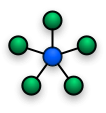PCR techniques: Difference between revisions
From OpenWetWare
Jump to navigationJump to search
(*** page creation ***) |
mNo edit summary |
||
| (19 intermediate revisions by 3 users not shown) | |||
| Line 1: | Line 1: | ||
[[Image:Hub icon.png|right]] | |||
Several techniques have have been derived from the basic polymerase chain reaction ([[PCR]]). Below is an overiew of important PCR methods with links to individual pages for detailed information. | |||
*[[ | *[[PCR]] ('''p'''olymerase '''c'''hain '''r'''eaction) is a method for exponentially amplifying a fragment of DNA in vitro. | ||
*[[ | *[[Nested PCR]] is 2 successive PCRs with the 2nd set of primers nested inside the 1st pair. It is used to reduce unspecific products. | ||
*[[ | *[[Multiplex PCR]] is a PCR with >1 primer pair run in a single reaction. It reduced material consumption but is hard to optimise. It is often used in mouse genotyping for example. | ||
*[[ | *[[Colony PCR]] is a PCR technique to detect DNA in bacterial colonies. Colonies are picked, lysed, and amplified by PCR. It is used to detect successful ligations or recombinations among large numbers of bacterial colonies. | ||
*[[ | *[[RT-PCR]] ('''r'''everse '''t'''ranscription PCR) is essentially normal PCR preceded by a reverse transcription converting RNA to cDNA. It is used to amplify an RNA molecule like messenger RNAs. Confusingly, RT-PCR is used as an abbreviation for real-time PCR. | ||
*[[Q-PCR]] ('''q'''uantitative PCR) is used to determine the quantity of starting nucleic acid template. There are 2 main methods: PCR with dsDNA dyes and PCR with probes. dsDNA dyes and probes allow measurement while the PCR is running, i.e. in real-time, and are therefore often named ''[[real-time PCR]]'' (see below). Probes are superior to dsDNA dyes but also more expensive. DNA can also be quantified with a simple PCR followed by agarose gel electrophoresis (qPCR end-point assay). If done properly with serial dilutions of starting DNA template to establish a linear relationship between band intensity and starting material, this approach is also quantitative. | |||
[http://en.wikipedia.org/wiki/Polymerase_chain_reaction#Practical_modifications_to_the_PCR_technique] | *[[Real-time PCR]] is used to determine the quantity of DNA during the PCR step (i.e. in "real-time") and thus a subset of the Q-PCR methods. It uses fluorescent dyes or fluorophore-DNA probes to measure the amount of amplification in real time. This is used to infer starting amount. Real-time PCR is often confusingly abbreviated as RT PCR which overlaps with reverse transcription PCR. | ||
*[[qRT-PCR|Quantitative RT-PCR]] ('''q'''uantitative '''r'''everse '''t'''ranscription PCR) refers to quantitative PCR of cDNA (which has been reverse transcribed from RNA). Like quantitative PCR, you can quantify the starting RNA template either during the reaction ("real-time reverse transcription PCR") or at the end of the PCR step. | |||
**qRT-PCT can be done either in [[qRT-PCR/Single tube|one tube]] or [[qRT-PCR/Two tubes|two tubes]]. | |||
=== See also === | |||
* [http://en.wikipedia.org/wiki/Polymerase_chain_reaction#Practical_modifications_to_the_PCR_technique PCR on wikipedia] | |||
* [[PCR]] - how to do a standard PCR | |||
* [[Designing primers]] | |||
* [[Mouse tissue lysis for genotyping]] | |||
* [[PCR inhibitors]] | |||
[[Category:Protocol]] [[Category:In vitro]] [[Category:DNA]] [[Category:RNA]] [[Category:PCR]] | |||
Latest revision as of 03:30, 22 December 2011

Several techniques have have been derived from the basic polymerase chain reaction (PCR). Below is an overiew of important PCR methods with links to individual pages for detailed information.
- PCR (polymerase chain reaction) is a method for exponentially amplifying a fragment of DNA in vitro.
- Nested PCR is 2 successive PCRs with the 2nd set of primers nested inside the 1st pair. It is used to reduce unspecific products.
- Multiplex PCR is a PCR with >1 primer pair run in a single reaction. It reduced material consumption but is hard to optimise. It is often used in mouse genotyping for example.
- Colony PCR is a PCR technique to detect DNA in bacterial colonies. Colonies are picked, lysed, and amplified by PCR. It is used to detect successful ligations or recombinations among large numbers of bacterial colonies.
- RT-PCR (reverse transcription PCR) is essentially normal PCR preceded by a reverse transcription converting RNA to cDNA. It is used to amplify an RNA molecule like messenger RNAs. Confusingly, RT-PCR is used as an abbreviation for real-time PCR.
- Q-PCR (quantitative PCR) is used to determine the quantity of starting nucleic acid template. There are 2 main methods: PCR with dsDNA dyes and PCR with probes. dsDNA dyes and probes allow measurement while the PCR is running, i.e. in real-time, and are therefore often named real-time PCR (see below). Probes are superior to dsDNA dyes but also more expensive. DNA can also be quantified with a simple PCR followed by agarose gel electrophoresis (qPCR end-point assay). If done properly with serial dilutions of starting DNA template to establish a linear relationship between band intensity and starting material, this approach is also quantitative.
- Real-time PCR is used to determine the quantity of DNA during the PCR step (i.e. in "real-time") and thus a subset of the Q-PCR methods. It uses fluorescent dyes or fluorophore-DNA probes to measure the amount of amplification in real time. This is used to infer starting amount. Real-time PCR is often confusingly abbreviated as RT PCR which overlaps with reverse transcription PCR.
- Quantitative RT-PCR (quantitative reverse transcription PCR) refers to quantitative PCR of cDNA (which has been reverse transcribed from RNA). Like quantitative PCR, you can quantify the starting RNA template either during the reaction ("real-time reverse transcription PCR") or at the end of the PCR step.
See also
- PCR on wikipedia
- PCR - how to do a standard PCR
- Designing primers
- Mouse tissue lysis for genotyping
- PCR inhibitors